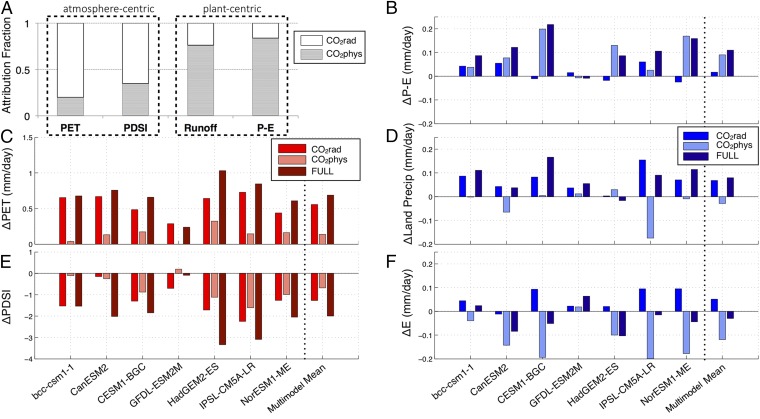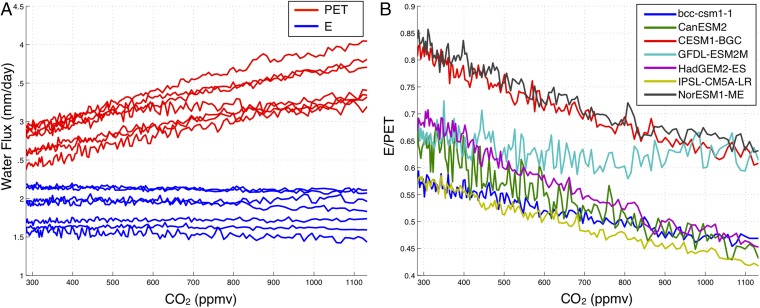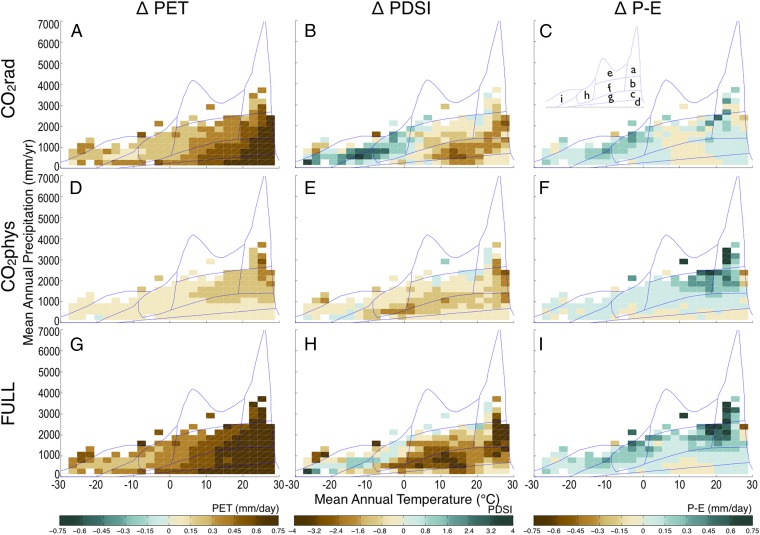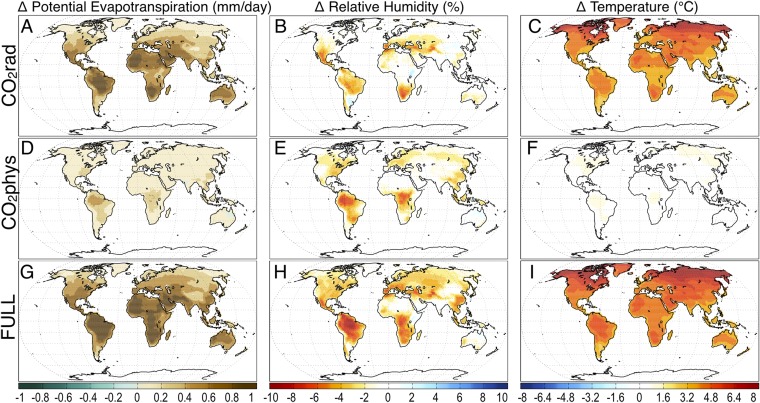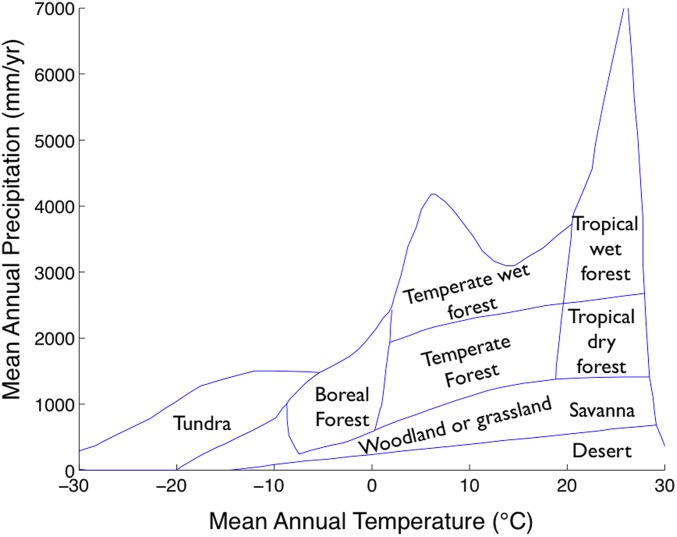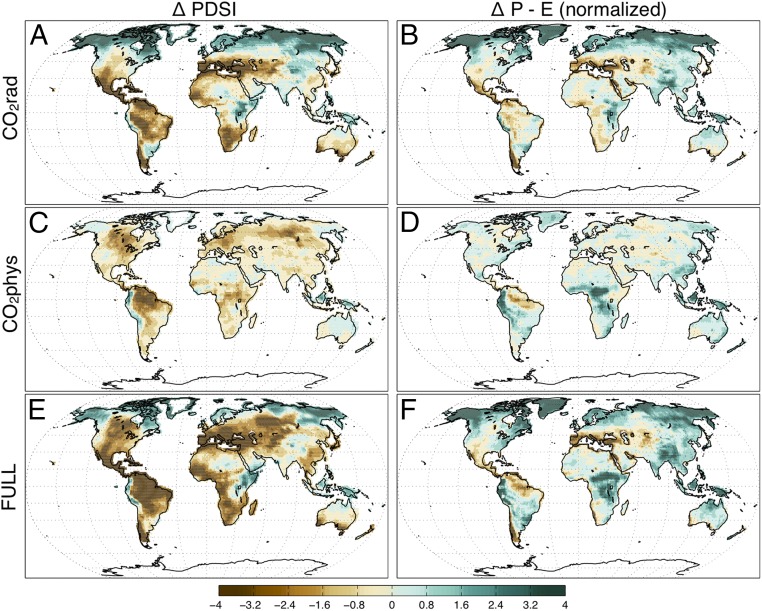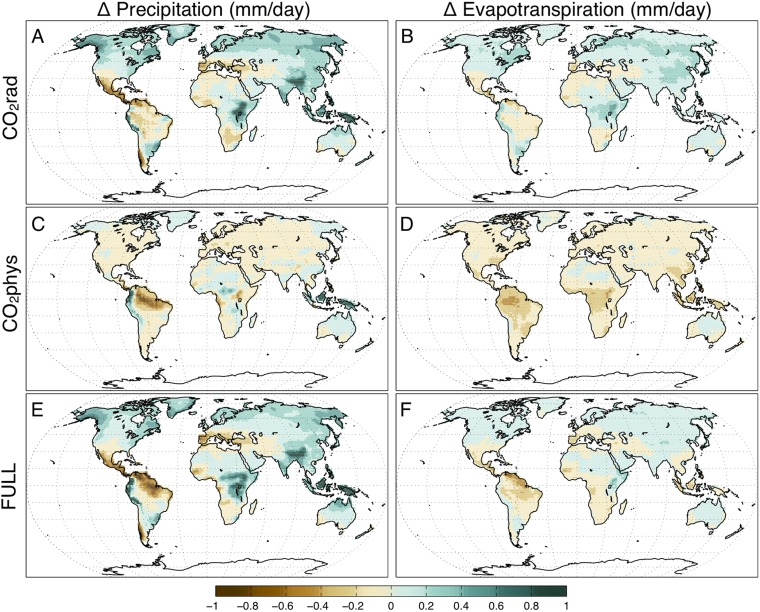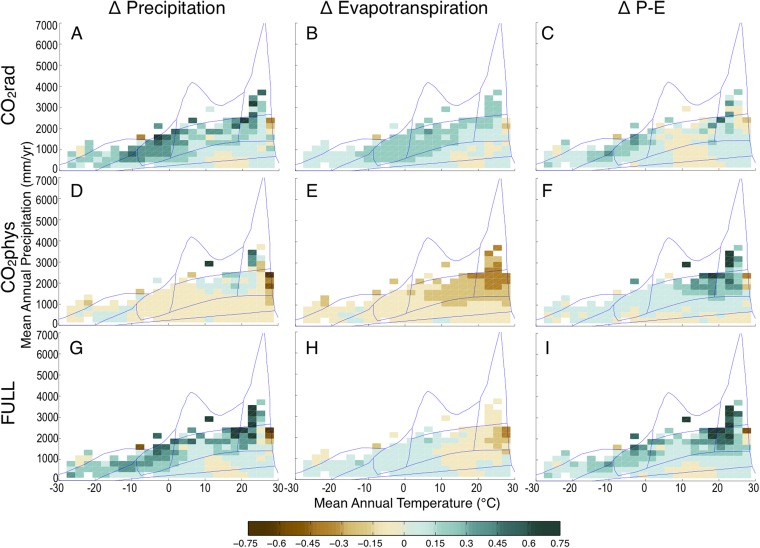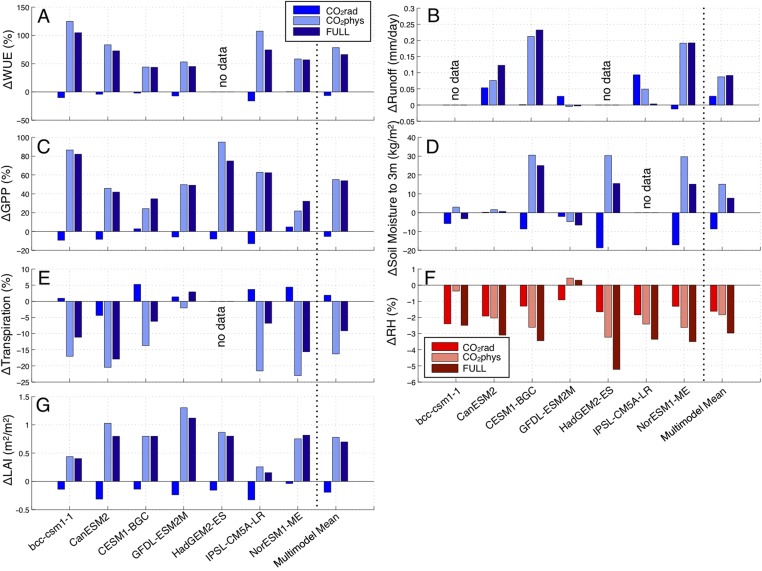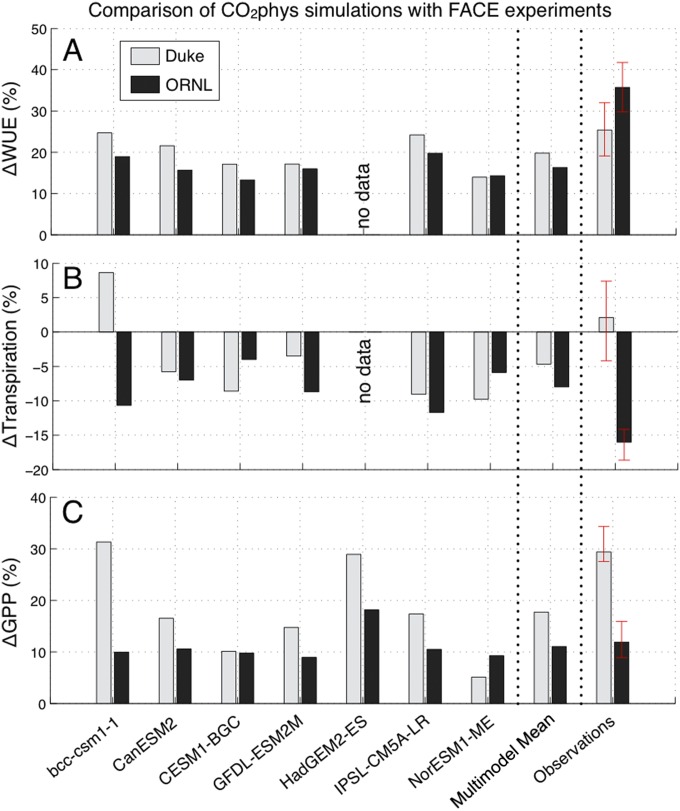Significance
We show that the water savings that plants experience under high CO2 conditions compensate for much of the effect of warmer temperatures, keeping the amount of water on land, on average, higher than we would predict with common drought metrics, and with a different spatial pattern. The implications of plants needing less water under high CO2 reaches beyond drought prediction to the assessment of climate change impacts on agriculture, water resources, wildfire risk, and vegetation dynamics.
Keywords: drought, global warming, climate impact, evaporation, global hydrology
Abstract
Rising atmospheric CO2 will make Earth warmer, and many studies have inferred that this warming will cause droughts to become more widespread and severe. However, rising atmospheric CO2 also modifies stomatal conductance and plant water use, processes that are often are overlooked in impact analysis. We find that plant physiological responses to CO2 reduce predictions of future drought stress, and that this reduction is captured by using plant-centric rather than atmosphere-centric metrics from Earth system models (ESMs). The atmosphere-centric Palmer Drought Severity Index predicts future increases in drought stress for more than 70% of global land area. This area drops to 37% with the use of precipitation minus evapotranspiration (P-E), a measure that represents the water flux available to downstream ecosystems and humans. The two metrics yield consistent estimates of increasing stress in regions where precipitation decreases are more robust (southern North America, northeastern South America, and southern Europe). The metrics produce diverging estimates elsewhere, with P-E predicting decreasing stress across temperate Asia and central Africa. The differing sensitivity of drought metrics to radiative and physiological aspects of increasing CO2 partly explains the divergent estimates of future drought reported in recent studies. Further, use of ESM output in offline models may double-count plant feedbacks on relative humidity and other surface variables, leading to overestimates of future stress. The use of drought metrics that account for the response of plant transpiration to changing CO2, including direct use of P-E and soil moisture from ESMs, is needed to reduce uncertainties in future assessment.
The demand for water by the atmosphere is widely predicted to increase due to climate change (1). It is commonly inferred that this will cause droughts to become more widespread and severe (2). Many recent studies, however, ignore the impact of rising atmospheric CO2 on plant water use (3–11). Plants absorb CO2 through stomates in their leaves, and simultaneously lose water to the atmosphere by means of transpiration through the same pathway. Higher atmospheric CO2 concentrations allow plants to reduce water losses per unit of carbon gain (12), in part by reducing stomatal conductance when the gradient of CO2 between the atmosphere and the leaf interior increases. If leaf area stays the same, this physiological response has the potential to reduce water losses from the land surface, increase soil moisture, and reduce plant water stress (13)—the opposite effect of an increase in drought stress and aridity as predicted by many drought metrics (3, 14, 15). A plant-centric view may therefore suggest that ecosystem-level tradeoffs between water loss and photosynthesis under increasing CO2 are potentially large enough to reduce drought, despite the large projected increases in water demand from a warmer atmosphere.
Drought indices, river routing schemes, and water balance models frequently use potential evapotranspiration (PET), rather than actual evapotranspiration, to estimate surface fluxes of water to the atmosphere (Tables S1 and S2). However, even the physically based estimates of this quantity (i.e., the Penman−Monteith equation) do not account for changes in transpiration caused by the physiological response of plants to increasing CO2, thereby making the implicit assumption that surface conductance is invariant with changing CO2. Although the climate implications of the physiological effects of CO2 on plants have been recognized in the literature (16–18), the effects have not been well integrated into studies examining impacts and risks of climate change, including flood risk, water resource stress, predictions of future species distributions, agricultural productivity, and ecosystem processes. Further, the science community uses many different drought metrics (Table S1), and the relative sensitivity of these metrics to plant physiological responses has not been systematically quantified. Our current best estimate of the effects of plant physiology on water fluxes are already integrated within the Earth system models (ESMs) used in the Coupled Model Intercomparison Project, phase 5 (CMIP5), whereby changing atmospheric CO2 influences transpiration and thus soil moisture. Predictions of available water on land within an ESM are thus disconnected from predictions of drought stress derived from the same model's output using metrics that assume plant and canopy conductance of water remain invariant.
Table S1.
Drought metrics used to predict future drought (see ref. 54)
| Index category | Index |
| Drought indices not accounting for the influence of atmospheric CO2 on plant physiology | PDSI |
| Aridity (P/PET) | |
| Standardized Precipitation Evaporation Index (SPEI) | |
| Standardized Precipitation Index (SPI) | |
| Z-index from Palmer | |
| Palmer hydrologic drought index | |
| Rainfall deciles | |
| Drought indices accounting for the influence of atmospheric CO2 on plant physiology | P-E |
| Runoff Deficit Index | |
| Soil Moisture | |
| Surface Water Supply | |
| Terrestrial water storage anomalies | |
| Total Water Deficit |
Table S2.
Impact assessment that depends on soil water, and thus plant physiology
| Climate impact | Dependence on plant responses to CO2 |
| Drought | Drought metrics that use PET as a driver or assume climatological surface conductance as relevant boundary condition for the future (i.e., PDSI, SPEI, SPI, rainfall deciles) are insensitive to the physiological effects of rising CO2 on plants. |
| Fire | Fire weather indices often include variables that respond to changes in atmospheric water demand, including air temperature and relative humidity. Elevated levels of atmospheric CO2 may maintain or increase soil moisture in some areas. Higher levels of soil moisture may make live fuels and deeper organic soil layers less susceptible to burning. |
| Agriculture | Statistical models used to assess the impacts of climate on crop yield often do not explicitly consider CO2 because of the difficulty in separating the influence of rising CO2 from long-term changes in management and fertilizer use. Long-term projections derived from short-term (interannual) responses of crops to climate variability may underestimate important interactions between elevated CO2 and climate change. |
| Biogeography modeling | Predictions of species distributions using climate envelope-type models often rely on temperature and precipitation, and rarely use soil moisture or P-E as metrics of future water availability. |
To quantify the effect of increasing CO2 concentrations on the prediction of drought, we compare idealized experiments for seven ESMs from the CMIP5 archive originally intended to constrain carbon−climate feedbacks, each with a 1% per year increase (from 284 ppm to 1,140 ppm over 140 y) in CO2 mole fractions, but with the increasing CO2 influencing different components of the Earth system. We use three experiments to separate the physiological and atmospheric radiative forcing contributions to different hydrologically relevant quantities. One of the three experiments isolates the effect of CO2 on atmospheric radiative forcing (CO2rad), so that increases in CO2 solely influence atmospheric radiative transfer within the ESM. The second experiment isolates the effect of CO2 on plant physiology (CO2phys), so that CO2 directly influences only photosynthetic processes. A third fully coupled experiment combines both effects (FULL) (Materials and Methods). We define plant-centric variables or metrics as those that explicitly include the influence of atmospheric CO2 on plant processes and evapotranspiration. Variables within this class include precipitation minus evapotranspiration (P-E), runoff, and soil moisture. Similarly, we define atmosphere-centric variables and metrics as those that do not allow for surface conductance to change in response to increasing CO2. Variables within this class include PET and the Palmer Drought Severity Index (PDSI). As commonly formulated, PET is calculated with time-invariant surface conductance (19). Although it is theoretically possible to formulate PET with a sensitivity of conductance to atmospheric CO2, in practice, this is rarely done because it requires estimating the influence of CO2 on stomatal conductance, leaf area, and other ecosystem processes. In past work, PDSI has been used as a measure of soil water availability (i.e., refs. 3, 4, and 20) and thus representative of hydrologic drought. We classify it here as atmosphere-centric because PDSI is derived using PET and therefore does not allow for plants to modify surface conductance, yielding a sensitivity to future change driven solely by changing meteorological conditions.
Results and Discussion
All of the models predict increases in PET in the fully coupled simulation both at the global scale (Figs. 1 and 2) and widely across climate space (Fig. 3), with 80% of the change at midlatitudes and lower latitudes attributable to the radiative effects of CO2 (Fig. 1A). The fully coupled response is anticipated from previous work, which shows that increases in PET under future climate change are mainly caused by increases in temperature and vapor pressure deficit (15). Similarly, PDSI, which accounts for both PET and precipitation, decreases in all of the fully coupled simulations in the global average (Fig. 1E)—suggesting greater drought stress. Plant physiological responses to CO2 enhance the contributions from CO2 radiative forcing by a small amount for PET and by a moderate amount for PDSI, as a consequence of stomatal responses generating a small level of additional warming and contributing substantially to reductions in surface relative humidity (Table S3 and Fig. S1). Drought stress increases for 76% of midlatitude and low-latitude land area when assessed using PDSI.
Fig. 1.
Midlatitude and low-latitude changes in atmosphere-centric (reds) and plant-centric (blues) metrics and variables, and the attribution of variables to the physiological or radiative effects of CO2. (A) Fraction of the response in the FULL experiment attributable to the CO2rad (white) and CO2phys experiments (gray). The difference in the annual mean for latitudes between 45°S and 45°N over a quadrupling of CO2 is shown for each of three experiments for seven climate models from the CMIP5 archive and the multimodel mean for (B) P-E over land (millimeters per day) where larger values indicate more water availability on land, (C) PET (millimeters per day) where larger values indicate more water loss from the land, (D) P over land (millimeters per day), (E) PDSI where larger negative values indicate more severe drought, and (F) E (millimeters per day) where positive values indicate a larger flux from the land to the atmosphere.
Fig. 2.
Time series of (A) PET (red lines) and E (blue lines) in millimeters per day for the midlatitude and low-latitude average from each of seven models using the FULL simulation, demonstrating that E remains relatively constant as CO2 increases despite large increases in PET. (B) The ratio between E and PET, averaged over midlatitudes and low latitudes, for each of seven models (identified by color), demonstrating a similar divergence across models between E and PET as CO2 increases. Note that the GFDL-ESM2M simulation only increases to a doubling of CO2 (568 ppm by volume), then holds the atmospheric CO2 concentration fixed; this explains the relatively small changes in E/PET shown during the latter half of the GFDL-ESM2M simulation.
Fig. 3.
The change in the multimodel mean of (A, D, and G) PET in millimeters per day, (B, E, and H) PDSI, and (C, F, and I) P-E in millimeters per day for each experiment plotted as the average of all spatial grid points falling at a certain annual average temperature and annual average precipitation. Results are shown for three experiments: (A−C) CO2rad, (D−F) CO2phys, and (G−I) FULL. Green colors indicate more water on land, and brown colors indicate less water on land. Blue lines outline biome ranges as reported in ref. 48, shown in Inset in C identified as: a, tropical wet forest; b, tropical dry forest; c, savanna; d, desert; e, temperate wet forest; f, temperate forest; g, woodland or grassland; h, boreal forest; and i, tundra (see also Fig. S6).
Table S3.
Change in the multimodel annual mean over land between 45°S and 45°N for each variable between the average of the last 20 y and the average of the first 20 y for each of three experiments
| Variable | Unit | Experiment | Attribution fraction | |||
| CO2rad | CO2phys | FULL | CO2rad | CO2phys | ||
| PET | mm/d | 0.558 | 0.139 | 0.689 | 0.80 | 0.20 |
| PDSI | −1.272 | −0.679 | −1.994 | 0.65 | 0.35 | |
| P-E | mm/d | 0.017 | 0.090 | 0.110 | 0.16 | 0.84 |
| Precipitation | mm/d | 0.068 | −0.029 | 0.080 | 1.74 | −0.74 |
| E | mm/d | 0.051 | −0.119 | −0.030 | −0.76 | 1.76 |
| Runoff | mm/d | 0.033 | 0.105 | 0.142 | 0.24 | 0.76 |
| Soil Moisture | kg/m2 | −8.693 | 15.049 | 7.738 | −1.37 | 2.37 |
| WUE | percent | −6.544 | 78.48 | 66.17 | −0.09 | 1.09 |
| T | K | 3.965 | 0.485 | 4.384 | 0.89 | 0.11 |
| RH | percent | −1.619 | −1.833 | −2.971 | 0.47 | 0.53 |
Each variable is the average of seven models, with the exception of soil moisture and WUE, which are the average of six models, and runoff, which is the average of five models. Soil moisture is integrated column moisture to a depth of 3 m. T, near-surface air temperature; RH, relative humidity.
Fig. S1.
Maps of the multimodel mean difference as in Fig. 4 for (A, D, and G) PET in millimeters per day, (B, E, and H) relative humidity in percent, and (C, F, and I) near-surface air temperature in degrees Celsius. A−C represent an experiment with only CO2rad, D−F represent an experiment with only CO2phys, and G−I represent the FULL model.
Fig. S6.
World biome types shown as blue outlines in Fig. 3 and Fig. S3 with corresponding biome labels as in ref. 48.
Using metrics that integrate plant physiological responses to changing CO2, we find that the pattern of future drought stress is considerably different. All of the fully coupled experiments show an increase in P-E when averaged across midlatitude and low-latitude regions, with the exception of one model that shows little change (Fig. 1B). The increases in P-E indicate a reduction in future drought stress, contrasting with the drought response inferred from PDSI. In the fully coupled simulation, 84% of the change in P-E at midlatitudes and lower latitudes is attributable to physiological responses to increasing CO2 (Fig. 1A). We find increases or little change in P-E across most of climate space (Fig. 3I). In contrast with PDSI, only 43% of midlatitude and lower-latitude land surface (and 37% globally) has increasing drought stress when assessed using P-E. Continental-scale changes in P-E suggest that drought stress may decrease in many parts of Asia, central and south Africa, Australia, and South America (Fig. 4). This directly contrasts with the predicted response inferred from PDSI and many drought assessments for these regions (e.g., refs. 3 and 4). The two approaches provide consistent estimates of increasing drought stress in other regions, including southern North America, northeastern South America, and southern Europe (Fig. S2). Higher levels of agreement between the two approaches occur in regions where projected changes in precipitation tend to be more robust (2).
Fig. 4.
Maps of the multimodel mean difference over a quadrupling of CO2 for (A, C, and E) PDSI and (B, D, and F) P-E normalized by the SD of the multimodel mean at each point. Green colors indicate more water on land, and brown colors indicate less water on land. A and B represent an experiment with only CO2rad, C and D represent an experiment with only CO2phys, and E and F represent the FULL model.
Fig. S2.
Maps of the multimodel mean difference as in Fig. 4 for (A, C, and E) P and (B, D, and F) E, both in millimeters per day. A and B represent an experiment with only CO2rad, C and D represent an experiment with only CO2phys, and E and F represent the FULL model.
The moderate increase in water available on land, inferred from changes in P-E, is due to both an overall increase in P (Fig. 1D and Figs. S2 and S3) and relatively small changes in E (Figs. 1F and 2 and Figs. S2 and S3). Precipitation increases in runs with radiatively coupled CO2 (Fig. 1D), as more energy and atmospheric water vapor are available to drive rainfall in a warmer climate (21). Evapotranspiration, by contrast, remains nearly unchanged from the initial values in the multimodel mean, as a consequence of the individual plant physiology and CO2 radiative forcing drivers inducing large and opposing changes (Fig. 2 and Figs. S2 and S3). Because P and E simultaneously increase in CO2rad, P-E shows little relative change (Fig. 1B). In contrast, E decreases whereas P shows little change in CO2phys, and thus most of the attribution of P-E change in the fully coupled simulation is to the influence of plant physiology (84%; Fig. 1A and Table S3). Modeled changes in soil moisture and runoff are consistent with changes in P-E, albeit with larger intermodel variability owing to significant uncertainty associated with global-scale model representations of these processes (Fig. S4).
Fig. S3.
The change in the multimodel mean, as in Fig. 3, of (A, D, and G) P in millimeters per day, (B, E, and H) E in millimeters per day, and (C, F, and I) P-E in millimeters per day in comparing the change over each experiment plotted as the average of all spatial grid points falling at a certain annual average temperature on the x axis, and annual average precipitation on the y axis. Results are shown in A−C for an experiment with only CO2rad, in D−F for an experiment with only CO2phys, and in G−I for the FULL model. Blue lines outline biome ranges as reported in ref. 48 and shown in Fig. S6.
Fig. S4.
Midlatitude and low-latitude changes in atmosphere-centric (reds) and plant-centric (blues) metrics and variables. The difference in the annual mean for latitudes between 45°S and 45°N over a quadrupling of CO2 is shown for each of three experiments for seven climate models from the CMIP5 archive and the multimodel mean for (A) WUE, which is the ratio of carbon uptake through photosynthesis to water lost through evapotranspiration (percent), (B) runoff (millimeters per day) where larger values indicate more water loss from the land, (C) GPP (in percent), (D) soil moisture integrated to 3 m depth (kilograms per square meter) where larger values indicate more water on land, (E) transpiration, the water flux through plants (percent), (F) relative humidity at the surface (percent), and (G) leaf area index (LAI, square meters per square meter).
Considering only atmosphere-centric drought and aridity metrics (such as PDSI), an approach taken in several recent papers (3, 5–11, 14), the prediction of drought stress in the future is dire. However, studies that use plant-centric metrics (P-E, soil moisture) tend to show a reduced impact (17, 22–25). Our analysis provides a conceptual framework and quantitative approach for reconciling many of these differences; divergence of these two approaches arises primarily from omission or consideration of the physiological effects of CO2 on plant water needs. Differences in impacts derived from the two types of metrics can be traced to diverging trajectories of PET and E within the models (Fig. 2); PET increases with CO2, whereas E remains relatively constant because of decreasing levels of canopy conductance. Further, our analysis indicates there is a potential for overestimating drought impacts using metrics derived from ESM model output; PET and PDSI changes are amplified by 19 and 36%, respectively, in the fully coupled simulation because of plant physiology responses to CO2 (Table S3). Use of these metrics, in turn, in offline analysis to assess crop and physiological drought would double count plant feedbacks on surface humidity, temperature, and net radiation, yielding estimates of future stress that are too high (Table S3 and Fig. S1).
The functional form of stomatal conductance–photosynthesis coupling algorithms integrated within ESMs (26) is generally supported by available observational data (27, 28); nonetheless, the relatively low diversity of representation of this process may contribute to the consistent spatial pattern in E observed across the models. The expected transpiration response of plants to increases in CO2 remains uncertain, as limited experimental observations of future conditions make it difficult to validate ecosystem-scale behavior of ESMs; however, existing observations tend to show decreases in transpiration and increases in water use efficiency (WUE) with increasing CO2. The simulations presented here compare moderately well with available field observations (28) (SI Materials and Methods and Fig. S5). For six of the seven CO2 physiology simulations evaluated here, widespread leaf area increases were not enough to offset the influence of decreasing stomatal conductance on E. As a consequence, for this set of models, CO2-driven growth effects were more than offset by CO2-driven decreases in transpiration in terms of impacts on the terrestrial water budget. In this context, an important future challenge is to increase the diversity and fidelity of coupling, carbon allocation, and dynamic vegetation algorithms within ESMs, and to develop more effective benchmarking approaches for evaluating these processes. Another important uncertainty is whether individual plant species can tolerate higher levels of atmospheric demand, particularly during seasonal periods of increasingly hot and dry weather (29). For example, intensification of evaporative demand during summers and greater interannual variability in moisture availability may accelerate forest mortality in the western United States (30).
Fig. S5.
Comparison of CO2phys simulations with observed changes at FACE experiments (see SI Materials and Methods). The average change in (A) WUE, (B) Transpiration, and (C) GPP is shown for the spatial location and CO2 range corresponding to the Duke (gray bars) and ORNL (black bars) FACE experiments for seven model simulations from the FULL experiment, as well as the multimodel mean. The median observed changes between ambient and elevated CO2 plots as reported in ref. 28 are shown on the far right, with red ranges showing the 25th and 75th percentile range in variability across years in each experiment (n = 11 at Duke, n = 4 at ORNL). Note that, as in ref. 28, the observed change in carbon flux is reported from a change in NPP rather than GPP.
A variety of assumptions are embedded in the choice of metrics used to evaluate the impact of climate change on water resources and land surface processes (Tables S1 and S2). In assessing agricultural drought, for example, it may be appropriate to consider total terrestrial water storage, as human appropriation of water from multiple sources (e.g., from mountain runoff, lakes, aquifers, and reservoirs) is likely to factor into regional adaptive responses to climate change. Drought-induced tree mortality may be best predicted by soil moisture anomalies, as predawn leaf water potential—which roughly equilibrates with soil water potential overnight—has been shown to be a predictive metric in the southwestern United States (30). In contrast, the appropriate metrics for evaluating fire need to capture the different processes regulating fuel moisture dynamics. Live fuel moisture is sensitive to plant water status and thus root-zone soil moisture, whereas coarse woody debris and surface duff layers may be more sensitive to changes in surface meteorology. Fire weather indices used in climate change studies often rely on atmosphere-centric metrics and variables, and this choice may not adequately capture the response of live fuels or deeper organic duff layers. Further, this study illustrates that relative humidity, a variable known to influence many aspects of fire behavior (31), responds to the influence of atmospheric CO2 on plant processes by an amount equal to or greater than the radiative effects of CO2 (Fig. S1 and Table S3). Considering these complexities, we recommend that metrics used to evaluate changes in the hydrological cycle draw upon plant-centric variables from ESMs that already explicitly consider the influence of plants on evapotranspiration, including P-E, soil moisture, runoff, and terrestrial water storage. Advances in measuring soil moisture and total water storage from satellites make these appealing choices for drought assessment (32, 33). By avoiding the use of derived estimates that rely on additional assumptions, it may be possible to reduce uncertainties in impact assessment.
Although the physiological response of plants to increases in CO2 could be less certain than ESMs suggest, our analysis provides evidence that the current assumption made in many drought prediction studies—that plant water needs will not respond to CO2—can lead to significant global-scale biases in predicting components of the hydrologic cycle and is not well supported by emerging evidence of increasing plant WUE and decreasing transpiration (34–36). The response of plant water needs to CO2 is already integrated within ESMs, and thus is already included in analysis of the physical climate reported in the Intergovernmental Panel on Climate Change Fifth Assessment (37). However, inconsistencies arise when an incomplete set of atmospheric and land surface variables from these ESMs is used to construct derived estimates of changing drought stress. Drought metrics such as PDSI have been important tools for assessing the spatial and temporal variability of contemporary drought. As the buildup of atmospheric CO2 continues to accelerate, however, more sophisticated measures that fully integrate plant and ecosystem responses to the direct effects of changing atmospheric composition are needed to enable policy makers to design effective solutions for managing climate change impacts.
SI Materials and Methods
There is significant uncertainty in the expected magnitude of response of ecosystems to future climate conditions. This includes quantities relevant to the findings we show here, such as transpiration, GPP, and WUE (WUE = GPP/transpiration). Existing observations of changes in any of the three variables under changing CO2 are limited and consist primarily of two types: (i) tree-ring–type analysis of WUE and growth change over past CO2 increases (34, 35, 49), and (ii) manipulation experiments such as free air CO2 enrichment (FACE)-type experiments where CO2 is elevated in an open-air environment for some time (50–52). Both of these types of experiments show increasing rather than static WUE as CO2 increases (28). Tree-ring studies in several cases do not find evidence of increased growth, implying that transpiration has likely decreased to realize increases in WUE (34, 35). The two forested FACE experiments show decreases (51) or little change (50) in transpiration associated with significant decreases in WUE (28).
Previous studies have found that land surface models tend to underestimate the response of WUE seen in observations (28), while possibly overestimating the response of GPP [i.e., CO2 fertilization effects too large (53)]. We estimate the behavior of the model simulations presented here against a similar range of conditions from two forested FACE experiments at Duke and Oak Ridge National Laboratory (ORNL). From the CO2phys experiments (Materials and Methods), we select the spatial grid cell and CO2 range that matches two FACE forest manipulation experiments and analyze the magnitude of response in WUE, GPP, and transpiration (Fig. S5). We find a multimodel mean increase in WUE of about 20% (σ across models = 4.4%) at Duke and about 16% (σ = 2.3%) increase at ORNL, compared with observational findings of 29.7 ± 13.8% (range is interannual variability; years = 10) at Duke and 37.6 ± 7.1% (years = 4) increase at ORNL (observations as reported in ref. 28). For transpiration, the multimodel mean drop of about 5% (σ = 6.3%) at Duke slightly overestimates the observed response of an increase of 2 ± 6%, whereas the 8% (σ = 2.6%) decrease at ORNL underestimates the observed response of and drop of 16 ± 2% (observations as reported in ref. 28). The percent change in each variable for individual models is presented in Fig. S5 with observational estimates as reported in figures 7 and 8 from ref. 28.
The larger than observed decrease in transpiration could be due to one of two inconsistencies between the CO2phys simulations and the conditions at FACE experiments. First, changes in surface fluxes from the model simulations are reported only for the grid cell average and not for different plant types. Duke and ORNL are located spatially close to one another yet have different plant types—hence the similar modeled response to changing CO2. Second, we use the CO2phys simulations for this comparison, which isolate the effect of increasing CO2 on plants in the absence of radiative forcing from that CO2, as is done in FACE experiments. However, the CO2phys simulations have preindustrial levels of radiatively active atmospheric CO2, and thus may have a cooler climate and lower transpiration rates in the mean state compared with FACE experiments.
Although global models such as the ones presented here do not perfectly replicate the limited available observations, the models are within the correct order of magnitude and, for most factors (WUE, transpiration at ORNL, and GPP), models underestimate rather than overestimate the response of plants to increasing CO2 observed in the FACE experiments.
Materials and Methods
We use the output from seven ESMs (38–44) from the CMIP5 archive (see Table S4) to (i) quantify the different continental patterns of drought derived from atmospheric centric and plant-centric metrics and (ii) separate the radiative and physiological impacts of increasing CO2 on different variables and metrics that are widely used in assessments of climate impacts on future drought. These models have full carbon cycles, which include leaf area on land that varies in response to climate and atmospheric CO2 mole fraction. Two single forcing runs and one fully coupled run were analyzed, each with an idealized 1% per year increase in CO2 emissions up to a quadrupling of preindustrial atmospheric CO2 mole fractions, with the exception of the GFDL-ESM2M model (see Table S4 for model information), which increased to a doubling of CO2 and was held fixed for the remainder of the run (45). In CO2phys runs (CMIP5 experiment name: esmFixClim1), plant physiology experiences the increase in atmospheric CO2, whereas the radiation code experiences fixed CO2. In CO2rad runs (CMIP5 experiment name: esmFdbk1), the radiation code experiences increasing CO2 whereas plant physiology does not. The third run analyzed, the FULL run (CMIP5 experiment name: 1pctCO2), is a combination of the two single forcing runs, where the carbon system is fully coupled, incorporating both effects. Change in a field due to increasing CO2 is calculated as the difference between the average of the last 20 y with the first 20 y of the simulation. Spatial averages (Fig. 1, Fig. S4, and Table S3) are reported for latitudes between 45°S and 45°N unless otherwise noted. The multimodel mean spatial maps (Fig. 4 and Figs. S1 and S2) were made by first regridding each model’s fields to a common 1° × 1° grid, then averaging the different models together.
Table S4.
Table of models used in this analysis with references
| Model | Modeling Center or Group | Reference | Stomatal Conductance |
| bcc-csm1-1 | Beijing Climate Center, China Meteorological Administration | (44) | Ball−Berry |
| CanESM2 | Canadian Centre for Climate Modeling and Analysis | (38) | Leuning |
| CESM1-BGC | Community Earth System Model Contributors | (42) | Ball−Berry |
| GFDL-ESM2M | NOAA Geophysical Fluid Dynamics Laboratory | (40) | Leuning |
| HadGEM2-ES | Met Office Hadley Centre | (41) | Simplified Leuning |
| IPSL-CM5A-LR | Institut Pierre-Simon Laplace | (39) | Ball−Berry |
| NorESM1-ME | Norwegian Climate Centre | (43) | Ball−Berry |
Seven models were included in this analysis (Table S4). The number of models was limited to those including all variables necessary for the analysis that include near-surface air temperature, near-surface relative humidity, sensible heat flux at the surface, latent heat flux at the surface, precipitation, gross primary production (GPP), and soil moisture. We additionally used the variables for surface winds and runoff where available. A few variables were corrected due to errors in the originally reported data: Relative humidity in the CanESM2 FULL run was adjusted by a factor of 100 and runoff in all runs from IPSL-CM5A-LR were adjusted by a factor of 48 to correct errors noted in the CMIP5 errata (cmip-pcmdi.llnl.gov/cmip5/errata/cmip5errata.html) and bring them into agreement with Earth System Grid Federation standard reporting units.
PET was calculated using the Penman−Monteith approach, as the PDSI has been shown to depend on the choice of formulation of PET (46, 47), and, as in ref. 15, using monthly mean surface values of temperature, latent heat flux, sensible heat flux, relative humidity, and winds. Where wind output was available from the model, it was used; otherwise, winds were held fixed at 1 m/s, as in ref. 3, which found that changes in winds were a minor contributor to future changes in PET. Models where winds were held constant are HadGEM2-ES and NorESM1-ME. PET is calculated using time- and space-invariant surface conductance, as is typical for global studies (e.g., refs. 3, 14, 15, and 19). The PDSI was calculated as in ref. 20 using a MATLAB script from B. Cook but substituting PET that we calculated using a Penman−Monteith algorithm. Values of PDSI larger than 20 or smaller than −20 were discarded as in ref. 3. The baseline period for PDSI was set to the first 20 y of the FULL model run for all experiments in a given model (including CO2rad and CO2phys).
The temperature (T) vs. precipitation plots (Fig. 3 and Fig. S3) were made by finding all of the grid cells with annual mean values that fall within each bin defined by bounds in temperature and precipitation and taking an area-weighted average. The multimodel mean of plots in this space was taken by averaging the T vs. P bins together for all models. T vs. P bins are shown only for values of T and P for which at least six models had a value.
The individual effects of radiation and physiology in the FULL experiment are linearly attributed to each of the single forcing components (Fig. 1A and Table S3) by calculating the fraction of the FULL run explained by each of the single forcing runs (CO2phys/FULL, CO2rad/FULL) and then normalizing by the sum of the total fraction explained by both (CO2phys/FULL + CO2rad/FULL). This is equivalent to calculating CO2phys/(CO2phys + CO2rad) as the attribution fraction of CO2phys and CO2rad/(CO2phys + CO2rad) as the attribution fraction of CO2rad. The attribution fraction can be larger than 1 if the two single forcing runs have changes of opposite sign. Values of the attribution fraction are plotted for some variables in Fig. 1A, and are shown in Table S3.
Acknowledgments
We thank B. Cook for sharing his software for calculating PDSI and M. Mu for help with retrieving data from the Earth System Grid Federation. A.L.S.S. was supported by National Science Foundation Grants AGS-1321745 and EF-1340649. F.M.H., C.D.K., and J.T.R. received support from the Regional and Global Climate Modeling Program in the Climate and Environmental Sciences Division of the Biological and Environmental Research Program in the US Department of Energy Office of Science. We acknowledge the organizations and groups responsible for CMIP, including the World Climate Research Programme, the climate modeling groups (listed in Table S4), and the US Department of Energy's Program for Climate Model Diagnosis and Intercomparison.
Footnotes
The authors declare no conflict of interest.
This article is a PNAS Direct Submission.
This article contains supporting information online at www.pnas.org/lookup/suppl/doi:10.1073/pnas.1604581113/-/DCSupplemental.
References
- 1.Manabe S, Wetherald RT. The effects of doubling the CO2 concentration on the climate of a general circulation model. J Atmos Sci. 1975;32:3–15. [Google Scholar]
- 2.Collins M, et al. Long-term climate change: Projections, commitments and irreversibility. In: Stocker TF, et al., editors. Climate Change 2013: The Physical Science Basis. Contribution of Working Group I to the Fifth Assessment Report of the Intergovernmental Panel on Climate Change. Cambridge Univ Press; Cambridge, UK: 2013. pp. 1029–1136. [Google Scholar]
- 3.Cook B, Smerdon J, Seager R, Coats S. Global warming and 21st century drying. Clim Dyn. 2014;43(9-10):2607–2627. [Google Scholar]
- 4.Dai A. Increasing drought under global warming in observations and models. Nat Clim Change. 2013;3(1):52–58. [Google Scholar]
- 5.Sheffield J, Wood EF. Projected changes in drought occurrence under future global warming from multi-model, multi-scenario, IPCC AR4 simulations. Clim Dyn. 2008;31(1):79–105. [Google Scholar]
- 6.Prudhomme C, et al. Hydrological droughts in the 21st century, hotspots and uncertainties from a global multimodel ensemble experiment. Proc Natl Acad Sci USA. 2014;111(9):3262–3267. doi: 10.1073/pnas.1222473110. [DOI] [PMC free article] [PubMed] [Google Scholar]
- 7.Swain S, Hayhoe K. CMIP5 projected changes in spring and summer drought and wet conditions over North America. Clim Dyn. 2014;44(9):2737–2750. [Google Scholar]
- 8.Asadi Zarch MA, Sivakumar B, Sharma A. Droughts in a warming climate: A global assessment of Standardized precipitation index (SPI) and Reconnaissance drought index (RDI) J Hydrol (Amst) 2015;526:183–195. [Google Scholar]
- 9.Cook BI, Ault TR, Smerdon JE. Unprecedented 21st century drought risk in the American Southwest and Central Plains. Sci Adv. 2015;1(1):e1400082. doi: 10.1126/sciadv.1400082. [DOI] [PMC free article] [PubMed] [Google Scholar]
- 10.Vicente-Serrano SM, der Schrier G, Beguería S, Azorin-Molina C, Lopez-Moreno J-I. Contribution of precipitation and reference evapotranspiration to drought indices under different climates. J Hydrol (Amst) 2015;526:42–54. [Google Scholar]
- 11.Zhao T, Dai A. The magnitude and causes of global drought changes in the 21st century under a low-moderate emissions scenario. J Clim. 2015;28(11):4490–4512. [Google Scholar]
- 12.Cowan IR. Stomatal behaviour and environment. Adv Bot Res. 1977;4:117–228. [Google Scholar]
- 13.Field CB, Jackson RB, Mooney HA. Stomatal responses to increased CO2: implications from the plant to the global scale. Plant Cell Environ. 1995;18(10):1214–1225. [Google Scholar]
- 14.Fu Q, Feng S. Responses of terrestrial aridity to global warming. J Geophys Res Atmos. 2014;119(13):7863–7875. [Google Scholar]
- 15.Scheff J, Frierson DMW. Scaling potential evapotranspiration with greenhouse warming. J Clim. 2014;27(4):1539–1558. [Google Scholar]
- 16.Sellers PJ, et al. Comparison of radiative and physiological effects of doubled atmospheric CO2 on climate. Science. 1996;271(5254):1402–1406. [Google Scholar]
- 17.Roderick ML, Greve P, Farquhar GD. On the assessment of aridity with changes in atmospheric CO2. Water Resour Res. 2015;51(7):5450–5463. [Google Scholar]
- 18.Betts RA, et al. Projected increase in continental runoff due to plant responses to increasing carbon dioxide. Nature. 2007;448(7157):1037–1041. doi: 10.1038/nature06045. [DOI] [PubMed] [Google Scholar]
- 19.Allen RG, Pereira LS, Raes D, Smith M, Ab W. 1998. Crop Evapotranspiration-Guidelines for Computing Crop Water Requirements (Food Agric Org, Washington, DC), Irrig Drainage Pap 56.
- 20.Palmer WC. Meteorological Drought. US Dep Commerce; Washington, DC: 1965. [Google Scholar]
- 21.Pendergrass AG, Hartmann DL. The atmospheric energy constraint on global-mean precipitation change. J Clim. 2013;27(2):757–768. [Google Scholar]
- 22.Orlowsky B, Seneviratne SI. Elusive drought: Uncertainty in observed trends and short- and long-term CMIP5 projections. Hydrol Earth Syst Sci. 2013;17(5):1765–1781. [Google Scholar]
- 23.Koirala S, Hirabayashi Y, Mahendran R, Kanae S. Global assessment of agreement among streamflow projections using CMIP5 model outputs. Environ Res Lett. 2014;9(6):064017. [Google Scholar]
- 24.Chen H, Sun J, Chen X. Projection and uncertainty analysis of global precipitation-related extremes using CMIP5 models. Int J Climatol. 2014;34(8):2730–2748. [Google Scholar]
- 25.Williams IN, Torn MS, Riley WJ, Wehner MF. Impacts of climate extremes on gross primary production under global warming. Environ Res Lett. 2014;9(9):094011. [Google Scholar]
- 26.Collatz GJ, Ball JT, Grivet C, Berry JA. Physiological and environmental regulation of stomatal conductance, photosynthesis and transpiration: A model that includes a laminar boundary layer. Agric Meteorol. 1991;54(2-4):107–136. [Google Scholar]
- 27.Medlyn BE, et al. Using ecosystem experiments to improve vegetation models. Nat Clim Change. 2015;5(6):528–534. [Google Scholar]
- 28.De Kauwe MG, et al. Forest water use and water use efficiency at elevated CO2: A model-data intercomparison at two contrasting temperate forest FACE sites. Glob Change Biol. 2013;19(6):1759–1779. doi: 10.1111/gcb.12164. [DOI] [PubMed] [Google Scholar]
- 29.Allen CD, Breshears DD, McDowell NG. On underestimation of global vulnerability to tree mortality and forest die-off from hotter drought in the Anthropocene. Ecosphere. 2015;6(8):129. [Google Scholar]
- 30.McDowell NG, et al. Multi-scale predictions of massive conifer mortality due to chronic temperature rise. Nat Clim Change. 2015;6(3):295–300. [Google Scholar]
- 31.Sedano F, Randerson JT. Multi-scale influence of vapor pressure deficit on fire ignition and spread in boreal forest ecosystems. Biogeosciences. 2014;11(14):3739–3755. [Google Scholar]
- 32.Entekhabi D, et al. The Soil Moisture Active Passive (SMAP) Mission. Proc IEEE. 2010;98(5):704–716. [Google Scholar]
- 33.Landerer FW, Swenson SC. Accuracy of scaled GRACE terrestrial water storage estimates. Water Resour Res. 2012;48(4):W04531. [Google Scholar]
- 34.Peñuelas J, Canadell JG, Ogaya R. Increased water-use efficiency during the 20th century did not translate into enhanced tree growth. Glob Ecol Biogeogr. 2011;20(4):597–608. [Google Scholar]
- 35.van der Sleen P, et al. No growth stimulation of tropical trees by 150 years of CO2 fertilization but water-use efficiency increased. Nat Geosci. 2015;8(1):24–28. [Google Scholar]
- 36.Warren JM, et al. Ecohydrologic impact of reduced stomatal conductance in forests exposed to elevated CO2. Ecohydrology. 2011;4(2):196–210. [Google Scholar]
- 37.Stocker TF, et al. Technical summary. In: Stocker TF, et al., editors. Climate Change 2013: The Physical Science Basis. Contribution of Working Group I to the Fifth Assessment Report of the Intergovernmental Panel on Climate Change. Cambridge Univ Press; Cambridge, UK: 2013. pp. 33–115. [Google Scholar]
- 38.Arora VK, et al. Carbon emission limits required to satisfy future representative concentration pathways of greenhouse gases. Geophys Res Lett. 2011;38(5):L05805. [Google Scholar]
- 39.Dufresne J-L, et al. Climate change projections using the IPSL-CM5 Earth System Model: From CMIP3 to CMIP5. Clim Dyn. 2013;40(9-10):2123–2165. [Google Scholar]
- 40.Dunne JP, et al. GFDL’s ESM2 global coupled climate−carbon Earth System Models. Part I: Physical formulation and baseline simulation characteristics. J Clim. 2012;25(19):6646–6665. [Google Scholar]
- 41.Jones CD, et al. The HadGEM2-ES implementation of CMIP5 centennial simulations. Geosci Model Dev. 2011;4(3):543–570. [Google Scholar]
- 42.Lindsay K, et al. Preindustrial control and 20th century carbon cycle experiments with the Earth system model CESM1(BGC) J Clim. 2014;27(24):8981–9005. [Google Scholar]
- 43.Tjiputra JF, et al. Evaluation of the carbon cycle components in the Norwegian Earth System Model (NorESM) Geosci Model Dev. 2013;6(2):301–325. [Google Scholar]
- 44.Wu T, et al. Global carbon budgets simulated by the Beijing Climate Center Climate System Model for the last century. J Geophys Res Atmos. 2013;118(10):4326–4347. [Google Scholar]
- 45.Taylor KE, Stouffer RJ, Meehl GA. An overview of CMIP5 and the experiment design. Bull Am Meteorol Soc. 2012;93(4):485–498. [Google Scholar]
- 46.Sheffield J, Wood EF, Roderick ML. Little change in global drought over the past 60 years. Nature. 2012;491(7424):435–438. doi: 10.1038/nature11575. [DOI] [PubMed] [Google Scholar]
- 47.Hobbins MT, Dai A, Roderick ML, Farquhar GD. Revisiting the parameterization of potential evaporation as a driver of long-term water balance trends. Geophys Res Lett. 2008;35(12):L12403. [Google Scholar]
- 48.Whittaker RH. Communities and Ecosystems. MacMillan; New York: 1975. pp. 111–191. [Google Scholar]
- 49.Frank DC, et al. Water-use efficiency and transpiration across European forests during the Anthropocene. Nat Clim Change. 2015;5(6):579–583. [Google Scholar]
- 50.Schäfer KVR, Oren R, Lai C-T, Katul GG. Hydrologic balance in an intact temperate forest ecosystem under ambient and elevated atmospheric CO2 concentration. Glob Change Biol. 2002;8(9):895–911. [Google Scholar]
- 51.Wullschleger SD, Gunderson CA, Hanson PJ, Wilson KB, Norby RJ. Sensitivity of stomatal and canopy conductance to elevated CO2 concentration—Interacting variables and perspectives of scale. New Phytol. 2002;153(3):485–496. doi: 10.1046/j.0028-646X.2001.00333.x. [DOI] [PubMed] [Google Scholar]
- 52.Ainsworth EA, Long SP. What have we learned from 15 years of free-air CO2 enrichment (FACE)? A meta-analytic review of the responses of photosynthesis, canopy properties and plant production to rising CO2. New Phytol. 2005;165(2):351–371. doi: 10.1111/j.1469-8137.2004.01224.x. [DOI] [PubMed] [Google Scholar]
- 53.Kolby Smith W, et al. Large divergence of satellite and Earth system model estimates of global terrestrial CO2 fertilization. Nat Clim Change. 2016;6(3):306–310. [Google Scholar]
- 54.Dai A. Drought under global warming: A review. Wiley Interdiscip Rev Clim Chang. 2011;2(1):45–65. [Google Scholar]
- 55.Ball JT, Woodrow IE, Berry JA. In: Progress in Photosynthesis Research. Biggins J, editor. Martinus Nijhoff; Dordrecht, The Netherlands: 1987. pp. 221–224. [Google Scholar]
- 56.Leuning R. A critical appraisal of a combined stomatal-photosynthesis model for C3 plants. Plant Cell Environ. 1995;18(4):339–355. [Google Scholar]



